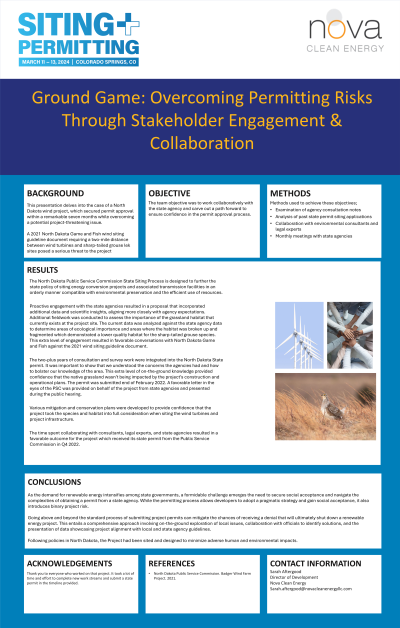Back

Multi-tech
Permitting Solutions
Ground Game: Overcoming Permitting Risks Through Stakeholder Engagement & Collaboration
Tuesday, March 12, 2024
5:00 PM – 6:00 PM MT


Sarah Aftergood
Director of Development
Nova Clean Energy, Texas
Presenter(s)
Presentation Description: As the demand for renewable energy intensifies among state governments, a formidable challenge emerges: the need to secure social acceptance and navigate the complexities of obtaining a permit from a stage agency. While the permitting process allows developers to adopt a pragmatic strategy and gain social acceptance, it also introduces binary project risk.
Going above and beyond the standard process of submitting project permits can mitigate the chances of receiving a denial that will ultimately shut down a renewable energy project. This entails a comprehensive approach involving on-the-ground exploration of local issues, collaboration with officials to identify solutions, and the presentation of data showcasing project alignment with local and state agency guidelines.
Illustrating the success of such strategies, this presentation delves into the case of a North Dakota wind project, which secured permit approval within a remarkable seven months while overcoming a potential project-threatening issue. The process involved the examination of agency consultation notes, analysis of past state permit siting applications, and collaboration with environmental consultants and legal experts. A 2021 North Dakota Game and Fish wind siting guideline document requiring a two-mile distance between wind turbines and sharp-tailed grouse lek sites posed a serious threat to the project, but proactive engagement with state agencies resulted in a proposal that incorporated additional data and scientific insights, aligning more closely with agency expectations.
Going above and beyond the standard process of submitting project permits can mitigate the chances of receiving a denial that will ultimately shut down a renewable energy project. This entails a comprehensive approach involving on-the-ground exploration of local issues, collaboration with officials to identify solutions, and the presentation of data showcasing project alignment with local and state agency guidelines.
Illustrating the success of such strategies, this presentation delves into the case of a North Dakota wind project, which secured permit approval within a remarkable seven months while overcoming a potential project-threatening issue. The process involved the examination of agency consultation notes, analysis of past state permit siting applications, and collaboration with environmental consultants and legal experts. A 2021 North Dakota Game and Fish wind siting guideline document requiring a two-mile distance between wind turbines and sharp-tailed grouse lek sites posed a serious threat to the project, but proactive engagement with state agencies resulted in a proposal that incorporated additional data and scientific insights, aligning more closely with agency expectations.
